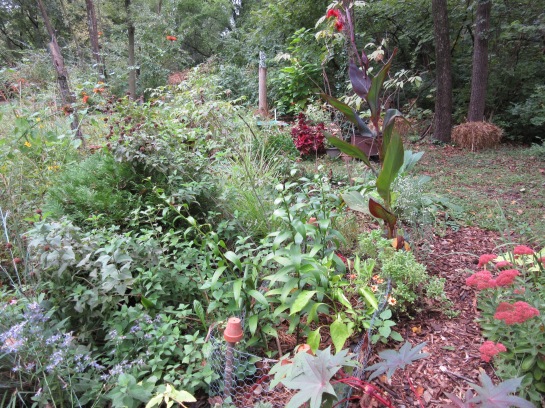JOURNAL September 2017
My ideal garden is a cross between a Victorian family farm and Ninfa. What I usually end up with is a cross between an unkempt laboratory and a set for the Planet of the Apes. “Right plant, right place” and “Nature bats last” are my primary principles, both inferring tolerance for a high degree of informality. Last Spring, I was stymied by a visitor who described the garden as “kind of municipal.” Was it the zinnias? Another friend called it “a good place to take a nap.” Whatever the garden is, this was it’s most floriferous year and I have the birds and bugs to prove it.

The Barrow of Thyme.

The yellow flowers of Bidens aristosa in the foreground, orange Thunbergia alata–one of the many plants called Black-Eyed Susan–on the tower behind. Red Amaranthus cruentus “Hopi Red Dye” on the lean.

The last of the “Poona Kheera” cucumbers.

Burnt-orange blooms of Helenium “Flammendes Kathchen” jostling with purple Shiso, Perilla frutescens, and Hopi Red Dye amaranth. Naked stem of red Ricinus up front. I’m a big fan of Rousseau.


Unknown pink-mottled, burgundy-leaved Coleus behind the fire pit.

Bottom to top: the waxy, variegated leaves of “Jack Frost” privet, Ligustrum japonicum; that unknown burgundy Coleus, which takes a surprising amount of afternoon sun; Ipomoea batatas “Sweet Caroline Bronze”; and, in the barrow, Zinna “Profusion Apricot,” yellow and white Lantana camara, and an expiring zucchini. The white Lantana, typically hardy to zone 10, over-wintered in open ground, zone 6b. A native/naturalized Euonymus climbing the elm tree.

The Ride, facing west.

The Ride, facing east.

Canna x generalis “Red King Humbert” blooming late. I would grow this for the foliage alone. Below, bush basil, wild aster and a potted banana seedling.

The Little Path, facing west. Bottom right, a toppled castor bean, Ricinus communis “Carmencita”; bottom left, the first blooms of the “Bluebird” aster, Symphyotricum laeve. Above are the ripening stems of “Scheherazade” lilies and the flopping stems of bee balm, Monarda fistulosa. The Chamaecyparis flopped upon is the second plant I put in this garden seven years ago. I owe my stolid Chamaecyparis friend two things: more shade from the afternoon sun, and to look up it’s full name. The rosy flowers of Sedum, ahem, Hylotelephium “Autumn Joy” attract an amazing number and variety of insects.

“Bluebird” aster sprawling on Rattlesnake Master, Eryngium yuccifolium, on the right, and a variegated Yucca filamentosa “Color Guard” at left. A blue “Moonglow” juniper seedling, Juniperus scopulorum, center right. Chives, red valerian, thyme and yarrow fill the gaps.

Okra does well here and I try new types regularly. “Stewart’s Zeebest” is a Louisiana heirloom touted as spineless, extra tender, smooth (no ribs), and heavy yielding. So far, its living up to it’s press: seven-inch pods are perfectly tender. Blaring red “Will Rogers” zinnias share the bed.

The Main Path, facing north. Right of center, the Popcorn Cassias, Cassia/Senna didimobotrya, have been struggling lately, shedding leaves and refusing to bloom. Might be too damp in that spot this year. Leaning in from the left, the extraterrestrial orange flowers of Lion’s Ear, Leonotis nepetifolia, a nuisance self-seeder this year–a mint, after all. Most of the plants are at least eight feet tall. In Autumn, they start to lean, a very efficient method for increasing their territory. If the plants aren’t pulled before the seed ripens, and the stems are allowed to fall, in Spring you’ll find clumps of easily transplanted seedlings coming up at least 10 feet from the parent. Lion’s Ear is a powerful hummingbird attractor.

The last tomato, “Amana Orange.” Misrepresented as an Amish heirloom, it was selected by Gary Staley of Brandon, Florida, in 1984. The fruit tended to crack this year but we had unusual summer rains. The fruits are a fetching shade of apricot-orange, the texture is meaty, the taste is good–more sweet than acid.

The Snake Path looking patchy. Baked, then drenched, all summer. The Blue Bed on the left is due for an overhaul. A storm at the end of the month flattened the Impatiens balsamina “Peppermint Stick,” and there was too much shade for the pineapple sages, Salvia elegans, to produce a decent flush of bloom.

Probably the last bloom on “Winter Sunset” for the season. It spent this year in a pot, recovering from a near-fatal rabbit encounter. It will go back in the ground in a couple of weeks.

Hosta “Guacamole” on the fade, attended by a self-sown orange Impatiens. The yellow Coleus to the right of the Impatiens is also self-sown. Serious zone-pushing this year. The plume poppy, Maclaeya cordata–those deeply cut, gray-green leaves–could use more sun.

The Dead Log elderberry patch was planted from cuttings in early March, in a small clearing between a mulberry tree and a walnut tree. The plants get three or four hours of direct sun a day, then mostly dappled shade. They’re looking well. “Heavenly Blue” morning glories on the trellis.

Potted Meyer lemon under-planted with a peachy Portulaca. Surrounding pots contain Agapanthus and “Apricot Profusion” zinnias.

Pelargoniums on the back patio.

Facing east. Snake Path on the left, Little Path to the right.

View from the table, September 26, 2017.


